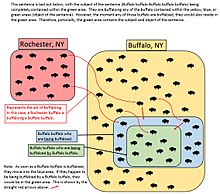Buffalo buffalo Buffalo buffalo buffalo buffalo Buffalo buffalo

S = sentence
NP = noun phrase
RC = relative clause
VP = verb phrase
PN = proper noun
N = noun
V = verb
"Buffalo buffalo Buffalo buffalo buffalo buffalo Buffalo buffalo" is a
The sentence employs three distinct meanings of the word buffalo:
- As an attributive noun (acting as an adjective) to refer to a specific place named Buffalo, such as the city of Buffalo, New York;
- As the verb to buffalo, meaning (in American English[1]) "to bully, harass, or intimidate" or "to baffle"; and
- As a noun to refer to the animal the buffalo (often called bison outside of North America). The plural is also buffalo.
A semantically equivalent form preserving the original word order is: "Buffalonian bison that other Buffalonian bison bully also bully Buffalonian bison."
Sentence construction
The sentence is unpunctuated and uses three different readings of the word "buffalo". In order of their first use, these are:
- a. a city named Buffalo. This is used as a noun adjunct in the sentence;
- n. the noun buffalo, an animal, in the plural (equivalent to "buffaloes" or "buffalos"), in order to avoid articles.
- v. the verb "buffalo" meaning to outwit, confuse, deceive, intimidate, or baffle.
The sentence is syntactically ambiguous; one possible parse (marking each "buffalo" with its part of speech as shown above) is as follows:
Buffaloa buffalon Buffaloa buffalon buffalov buffalov Buffaloa buffalon.
When grouped syntactically, this is equivalent to: [(Buffalonian bison) (Buffalonian bison intimidate)] intimidate (Buffalonian bison).
Because the sentence has a
An expanded form of the sentence that preserves the original word order is: "Buffalo bison that other Buffalo bison bully also bully Buffalo bison."
Thus, the parsed sentence claims that bison who are intimidated or bullied by bison do themselves intimidate or bully bison (at least in the city of Buffalo – implicitly, Buffalo, New York):
- Buffalo buffalo (animals called "buffalo" from the city of Buffalo) [that] Buffalo buffalo buffalo (that the same kind of animals from the city bully) buffalo Buffalo buffalo (bully these animals from that city).
- [Those] buffalo(es) from Buffalo [that are intimidated by] buffalo(es) from Buffalo intimidate buffalo(es) from Buffalo.
- Bison from Buffalo, New York, who are intimidated by other bison in their community in turn intimidate other bison in their community.
- The buffalo from Buffalo who are buffaloed by buffalo from Buffalo buffalo (verb) other buffalo from Buffalo.
- Buffalo buffalo (main clause subject) [that] Buffalo buffalo (main clauseverb) Buffalo buffalo (main clause direct object).
- Buffalo from Buffalo [that] buffalo [from] Buffalo buffalo [in turn] buffalo buffalo [from] Buffalo.


Usage
Origin
The idea that one can construct a grammatically correct sentence consisting of nothing but repetitions of "buffalo" was
Neither Rapaport, Pinker, nor Senghas were initially aware of the earlier coinages.[6] Pinker learned of Rapaport's earlier example only in 1994, and Rapaport was not informed of Borgmann's sentence until 2006.[6]
Versions of this linguistic oddity can be constructed with other words which similarly simultaneously serve as collective noun, adjective, and verb, some of which need no capitalization (such as "police").[9]
See also
General:
- Antanaclasis
- Eats, Shoots & Leaves
- List of linguistic example sentences
- Polyptoton
- Semantic satiation
Other linguistically complex sentences:
- James while John had had had had had had had had had had had a better effect on the teacher
- Lion-Eating Poet in the Stone Den (a Classical Chinese poem in which every syllable is pronounced as shi, though with varying tones).
- That that is is that that is not is not is that it it is
- Neko no ko koneko, shishi no ko kojishi(a Japanese sentence which can be written using the same character 12 times).
References
- Macmillan Dictionary. Retrieved 29 May 2021.on 2 June 2021. Retrieved 29 May 2021.
- Oxford University Press. "Definition of buffalo". Lexico. Archived from the original
External links
- Buffaloing buffalo at Language Log, 20 January 2005
- Easdown, David. "Teaching mathematics: The gulf between semantics (meaning) and syntax (form)" (PDF). (273 KB)
- William J. Rapaport, A History of the Sentence "Buffalo buffalo buffalo buffalo buffalo."
